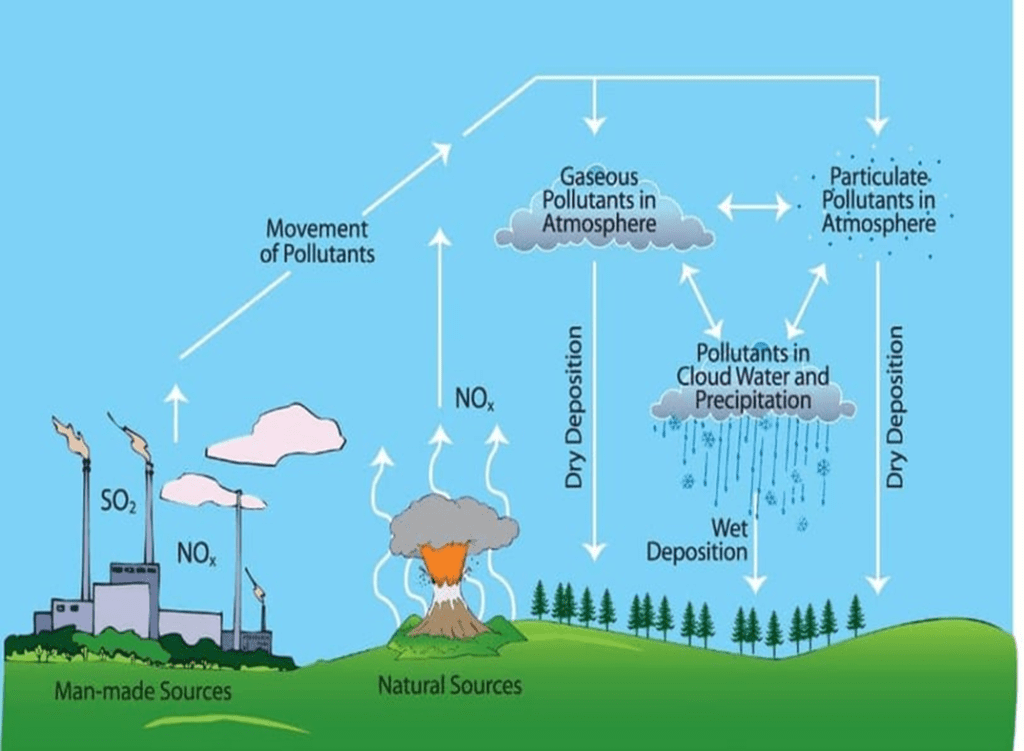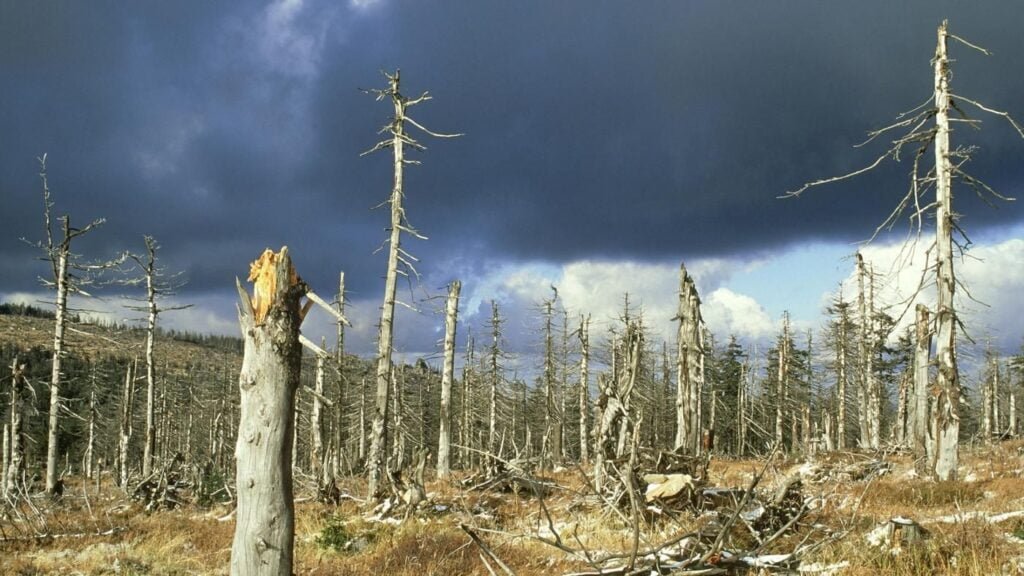This blog contains information about Acid Rain. In the start, it explains what is acid rain and then explains its formation process. Then it explains Chemical Composition of Acid rain. It also explains the significance of Acid Rain in detail. Then it mentions some Major Sources of Acid Rain. It also explain the Effects of Acid Rain. In the end, it mentions Control Measures of Acid Rain. This blog contains Sources and Effects of Acid Rain.
What is Acid Rain?
Acid rain is the formation of rain when the harmful compounds such as sulfur dioxide and nitrogen oxides are added into the air. These compounds combine with moisture and then fall on the Earth’s surface.
This rain is called acid rain because water molecules contain harmful gas particles and this cause destruction on the Earth’s Surface. It almost have the ingredients same as the smog. And we can say that it is the liquid version of Smog.
Formation of Acid Rain:
As we know that air pollutants such as sulfur dioxide and nitrogen oxides, rise up high in the atmosphere. There they combines with the clouds that will be the cause of rain recently. These pollutants undergo chemical reaction with water into the clouds and converts into nitric acid and sulfuric acid. It also combines with hydrochloric acid and in this way the first step of acid rain is completed which is the formation of Acid Rain in the atmosphere. After getting completely ready, these molecules travel with the clouds with the help of air and at the time of precipitation they fall back to the surface.
Chemical Composition of Acid Rain:
• SO3(g) + H2O(l) —> H2SO4(aq.)
• 4NO2(g) + O2(g) + 2H2O(l) —> 4HNO3(aq.)
Two types of deposition can be seen in the formation of acid rain:
Wet Deposition:
Wet deposition occurs when these harmful gases combines with water and are then released in the atmosphere. This type of deposition includes rain, fog, and snow.
• Plants, as well as animals, are affected as the wet deposition falls to the ground.
Dry Deposition:
In dry areas., the acid chemicals may become incorporated into dust or smoke and fall to the ground through dry deposition.
• Sticking to the ground, buildings, homes, cars, and trees etc.
Significance of Acid Rain:
Acid rain is a significant natural phenomenon because it pollutes the water resources, plants, land, discolor furnishing and much more. It is equivalent to throwing acid drops onto the surface. Humans have to face many problems after acid rain because it pollutes land, water and air of the Earth. Their effects at extreme, are harmful for the humans and other living systems of the Earth.

Major Sources of Acid Rain:
Major sources of Acid Rain includes, fuel burning, industrial purposes, nitrogen-rich fuels, sulfur containing fuels, natural activity of bacteria, seed germination, smog formation etc. All these are the reason of the formation of Acid Rain into the atmosphere. This makes a cycle of pollutants going from the earth to the atmosphere and then coming back to Earth by Acid Rain. This blog contains Sources and Effects of Acid rain.
Effects of Acid Rain:
Following are the effects of Acid Rain:
• Water Pollution:
When Acid Rains falls onto the surface, it pollutes all the water reservoirs, rivers and the ocean. It is a big reason of Ocean Acidification because it directly adds acids into the ocean water. In the same way it pollutes freshwater resources and wetlands. When acid rain adds to the aquatic environment it disturbs the oxygen levels in the water and cause sensitive organisms to die. It highly effect the composition of water bodies and harms the complete ecosystem.
• Destruction of Buildings and Historical Monuments
Acid rain leads to the decay of buildings by dissolving building material by acid exposure. Acid rain when exposed to old architecture and old monuments, the acidic molecules react with the old construction and cause their damage and decay. This phenomenon have already destroyed the appearance of many important historical monuments around the world. The concentration of acid in acid rain is increasing every year and this will result in more destructive results in future.
• Harmful for Trees and Forests:
Acid Rain seeps down into the ground and dissolve nutrients such as magnesium and calcium that are necessary for plant growth and tree development. This highly effects the physical appearance of the plants and destroy their mechanism. It is because sulfur oxides interfere the energy mechanism and photosynthesis of plants and trees. This can cause discoloration of leaves, yellowness of leaves and death of the leaves. In this way acid rain is dangerous for plants.
• Human Health issues:
Acid rain adds into the water and cause waterborne diseases in humans and animals. It also adds toxic gases with its evaporation in the atmosphere that highly effects human health and other living organisms. It can also cause skin diseases such as itching, irritation and redness and it can also lead to skin infections and skin cancer. As it is in liquid form, it do not cause any internal damage in the human body. But it effects the physical coating i.e. skin and sensitive organs like eyes and nose. People who are exposed to polluted water may get gastric diseases, kidney disorder and other water borne diseases.
All of these are the harmful effects of Acid Rain.
Control Measures for Acid Rain:
As we know that the base of acid rains is NOx and SO2 emissions. So, in order to prevent acid rain, we should control Green House Gases (GHGs emissions):
We can utilize green and clean energy to reduce the emissions.
We can use scrubbers and catalytic converters to reduce pollution.
Apply denitrification and desulfurization for cleaning fuels.
Less use of fossil fuels
Energy conservation can prevent acid rain
Public awareness will help to reduce GHG emissions that lead to Acid Rain.
By all these Control Measures we can prevent extreme Acid Rains. This blog contains Sources and Effects of Acid Rain.

To learn about more topics, click the links below:


Comments